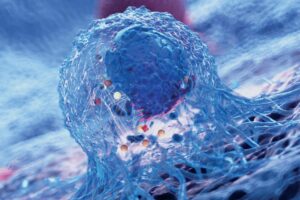What is already known
The correlation between the diversity of gut microbiota and survival following allogeneic hematopoietic stem cell transplantation (allo-HSCT) has been predominantly investigated in adults. However, research on pediatric patients raises the question of whether this correlation is also applicable to children.
What this research adds
A recent study analyzed the composition of the gut microbiota from a cohort of 90 pediatric patients who underwent allo-HSCT. Based on their gut microbiota diversity before the transplantation and at the neutrophil engraftment, patients were divided into higher and lower-diversity groups. The higher diversity group before transplantation showed a greater probability of overall survival and a reduced incidence of acute graft-versus-host disease (aGvHD), with higher relative abundance of potentially beneficial microbial families, such as Ruminococcaceae and Oscillospiraceae. In contrast, the lower-diversity group had an overabundance of Enterococcaceae and Enterobacteriaceae. Interestingly, there was no significant difference in relapse-free survival between these two groups.
Conclusions
Results from the study suggest a correlation between the diversity and composition of the gut microbiota prior to transplantation and both the patient’s survival and the probability of developing aGvHD.
Allogeneic hematopoietic stem cell transplantation (allo-HSCT) offers a potential cure for various pediatric hematologic malignancies and non-malignant conditions. However, the effectiveness of this treatment is hampered by transplant-related mortality (TRM), which results from complications such as acute graft-versus-host disease (aGvHD) and infections.
The allo-HSCT has a profound impact on the gut microbiota (GM) of patients. This disruption, known as dysbiosis, is characterized by a significant reduction in bacteria diversity, depletion of beneficial commensal bacteria, and an increase in potentially harmful bacteria. Moreover, recent data have shown that GM alterations prior to allo-HSCT may play a role in the development of transplant-related complications.
Although the incidence of complications like aGvHD and TRM in children is lower than in adults, the risks remain substantial, with most fatal events attributed to organ failure and infections. However, few studies have explored the relationship between GM changes and clinical outcomes in pediatric patients undergoing allo-HSCT.
A recent study by Turroni and colleagues, published on Blood journal, investigated the association between GM diversity and clinical outcomes in pediatric allo-HSCT recipients, and found that higher microbiota diversity before transplantation correlates with better overall survival and lower aGvHD incidence.
Association between microbiota diversity and clinical outcomes
Researchers collected pre-transplant and post-allo-HSCT stool samples from a cohort of 90 patients and performed RNA sequencing to characterize their gut microbiota. They observed a significant reduction in microbiota diversity from before allo-HSCT to the point of neutrophil engraftment. Furthermore, there was a notable discrepancy in overall survival (OS) between the two groups, with patients with higher diversity demonstrating higher OS rates post-allo-HSCT compared to those in the lower-diversity group. However, no statistically significant disparities emerged between the higher- and lower-diversity groups in terms of the incidence of relapse and relapse-free survival.
In the higher-diversity group, there was a significantly lower occurrence of aGvHD, whereas there were no discernible distinctions between the groups in terms of TRM. In the context of microbiota diversity at neutrophil engraftment, no notable variations in outcomes were observed between the higher- and lower-diversity groups in relation to OS, relapse-free survival, aGvHD, gut aGvHD, and TRM.
Gut microbiota composition across transplant stages
Patients who experienced a positive survival outcome exhibited higher microbial diversity before allo-HSCT. Conversely, among the samples with lower diversity, several were marked by an increased presence of Escherichia-Shigella, Enterococcus, Enterobacter, and Streptococcus. The analysis performed in the study confirmed the previously established association between the composition of the gut microbiota and the onset of aGvHD.
From a compositional point of view, the higher-diversity group before transplantation was characterized by higher relative abundances of the families Oscillospiraceae, Bacteroidaceae, Rikenellaceae, Ruminococcaceae, Prevotellaceae, Coriobacteriaceae, Christensenellaceae, and Tannerellaceae. Conversely, the lower-diversity group showed an overabundance of Enterococcaceae and Enterobacteriaceae. At the genus level, the GM of the higher-diversity group was characterized by higher proportions of Bacteroides, Dorea, Parabacteroides, Alistipes, Collinsella, Coprococcus, Roseburia, Faecalibacterium, Blautia, and members of the Ruminococcus and Eubacterium groups. On the other hand, the lower-diversity group was found to be particularly enriched in Escherichia-Shigella and Enterococcus. Moreover, antibiotic treatment before allo-HSCT significantly reduced the microbial diversity.
Analysis of samples from the point of neutrophil engraftment, revealed a clear distinction between the groups with higher and lower diversity. However, no robust connection between gut microbiota (GM) diversity at this particular time and overall survival (OS) was detected. Nevertheless, the examination did reveal several distinct compositional variations at both the family and genus levels when stratifying by higher versus lower diversity at the time of neutrophil engraftment.
In particular, the higher-diversity group showed higher levels of Lachnospiraceae, Ruminococcaceae, Eggerthellaceae, Erysipelotrichaceae, Tannerellaceae, Christensenellaceae, and Bacteroidaceae, and a trend towards lower levels of Enterococcaceae. At the genus level, engraftment samples with higher diversity were enriched in Lachnoclostridium, Subdoligranulum, Parabacteroides, and Bacteroides, as well as members of the Christensenellaceae group. On the contrary, relative abundances of Enterococcus tended to be higher in the lower-diversity group.
The aGvHD was not found to be linked to microbial diversity, either before the transplantation procedure or at the time of neutrophil engraftment. However, higher pre-allo-HSCT levels of Blautia and Ruminococcus appeared to be protective against the subsequent development of aGvHD, consistent with existing literature.
These distinctive microbial signatures were more pronounced when specifically examining cases of grade III-IV aGvHD. The occurrence of severe aGvHD was also associated with elevated pre-allo-HSCT levels of Streptococcus, Actinomyces, Lacticaseibacillus, Rothia, and members of the Ruminococcus group. Notably, no distinct taxonomic signatures in the gut microbiota were identified at the time of neutrophil engraftment in relation to the onset of aGvHD.
Network analysis
The microbiota networks of the higher- and lower-diversity groups were examined using a correlation networking method before allo-HSCT and at the time of neutrophil engraftment. Before allo-HSCT, in the GM network of patients in the lower-diversity group, showed keystone taxa such as Enterococcus, Escherichia-Shigella, Enterobacter, and the Ruminococcus group. In contrast, for the higher-diversity group, keystone taxa such as Bacteroides, Blautia, Faecalibacterium, and Roseburia were identified.
The lower-diversity group exhibited an abundance of various bacteria, including Enterococcus, Escherichia-Shigella, Rothia, Enterobacter, Anaerococcus, Klebsiella, Pseudomonas, Anaerobacillus, Bacillus, Proteus, and Acinetobacter. In contrast, the network structure of the higher-diversity group had minimal representation of these bacteria. Instead, the overall configuration was predominantly characterized by 323 producers of short-chain fatty acids (SCFA) as well as numerous other commensals.
Overall, the present study provides evidence of a link between reduced gut microbiota (GM) diversity before transplantation and unfavorable outcomes and poorer outcome in children undergoing allo-HSCT. It is worth nothing that this analysis also involved the largest pediatric cohort ever examined for GM composition during the allo- HSCT period.
Furthermore, this study highlights potential avenues for targeted interventions in children aimed at their gut microbiota (GM), which could include nutritional modulation or even fecal microbiota transplantation. Notably, these findings shed light on the optimal timing for such interventions to enhance GM composition and subsequently improve transplant outcomes. Unlike in adults, it appears that the most opportune moment for intervention is before the allo-HSCT procedure.
Significantly, this opens up the prospect of preventing GM injury starting from the moment of diagnosis of oncological or hematological diseases. This approach enables the early implementation of personalized precision interventions tailored to patients based on their GM profiles. Nevertheless, it is crucial to emphasize that the safety and effectiveness of these interventions should be subject to dedicated interventional studies involving pediatric allo-HSCT recipients.
Additionally, the reduced GM diversity and increased relative abundance of Enterococcaceae in pre-allo-HSCT samples from patients who received antibiotics suggests that strategies aimed at reducing antibiotic usage during this critical period may help preserve a healthy gut microbiota.











